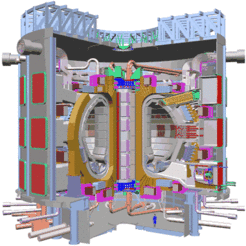Site agreed on for the ITER international fusion device
Cadarache (France) chosen / Japan obtains preferential terms

Already in May distribution of the investment costs of 4.6 billion euros among the host and the other parties had been settled in a bilateral "technical agreement" between Japan and Europe: The host – Europe as now decided – will meet the site costs, viz. 20 per cent of the total amount, half of this being borne by France. The remaining 80 per cent represents the actual building costs of the device: Europe assumes 30 per cent, Japan, China, Russia, the USA, and South Korea 10 per cent each, this essentially in the form of finished components that will be manufactured in the respective countries and then shipped to Cadarache. As compensation for not providing the ITER site Japan will be granted preferential terms: Japanese industry will be awarded production contracts amounting to 20 per cent of the total, half of this funded by the European contribution. Japan can also provide 20 per cent of the scientific personnel. Furthermore, the EU will contribute to other research projects in Japan that support the ITER project in the context of a "broader approach", e.g. to a materials test rig. Further particulars such as the legal form of the supranational project and its organisation are to be decided in a later agreement.
"We are very happy that this important decision on ITER has been reached and a European site chosen," states Prof. Dr. Alexander Bradshaw, Scientific Director of Max Planck Institute of Plasma Physics (IPP) at Garching and Greifswald. "The European fusion centres must now appropriately support ITER. A comprehensive accompanying fusion programme must ensure that in Europe – and hence in Germany – enough scientists are trained for fusion operation commencing in about ten years. It should also ensure that research and industry in the participating countries benefit from the results obtained in the ITER large-scale device and are thus equipped to plan and construct a fusion power plant."
The ITER experimental reactor is the next major step in fusion research worldwide. The device is intended to show that an energy-producing fusion fire is possible. ITER has been under preparation since 1988 as an international cooperation of European, Japanese, Russian, and – till 1997– US fusion scientists. In 2003 the project was joined by China and South Korea; the USA also rejoined. With a fusion power of 500 megawatts ITER is to produce the first ever burning and energy-yielding plasma. The goal is an energy gain factor of at least 10, i.e. ten times the energy needed to heat the plasma has to be gained as fusion energy. After a construction time of about ten years there will be some 600 scientists, engineers, and technicians working on the device for about twenty years. Constructions costs will amount to approx. 4.6 billion euros; running costs – including reserves for subsequent dismantling – are estimated at an annual 265 million euros.
IPP, one of the largest fusion centres in Europe, has spent years working on ITER-relevant questions with its ASDEX Upgrade fusion experiment. Some of the essentials of the physical principles for the test reactor were developed at IPP. With its ITER-like geometry, ASDEX Upgrade will continue in the future to play a major role, e.g. in the search for optimised operating modes for the test reactor. In addition, IPP is developing part of the plasma heating for ITER and methods of analysing the plasma. The international ITER planning group (Joint Work Site Europe) has been hosted by IPP at Garching since the start of the project in 1988. On commencement of construction of ITER it will, however, be transferred with some of the likewise hosted EFDA (European Fusion Development Agreement) group to Cadarache or Barcelona, where the "ITER European Legal Entity" will be domiciled.
Background: fusion as energy source
The objective of fusion research is to develop a power plant that – like the sun – produces energy from fusion of atomic nuclei. In order to ignite the fusion fire, the fuel – a plasma composed of the hydrogen isotopes, deuterium and tritium – has to be confined in magnetic fields and heated to high temperatures. A gramme of fuel could provide 90,000 kilowatt-hours of energy – the combustion heat derived from eleven tons of coal. The raw materials of fusion are available everywhere in almost inexhaustible quantities. As a fusion power plant also promises favourable environmental and safety properties, fusion could make a lasting contribution to future energy supply: Present know-how shows fusion to be a safe technology. A fusion power plant can be designed so as not to contain any energy sources that – should they get out of control – could destroy a safety shield from inside. So it cannot "run wild". Remaining as radioactive waste are the walls of the plasma vessel, which have to be put into intermediate storage on termination of operation. The activity of the waste quickly decreases: after about 100 years to a ten-thousandth of the initial value. If special materials with low activation potential and efficient recycling methods are developed, there would be no waste to isolate after a decay time of a hundred years. The entire material would then be cleared or re-used in new power plants.
On the way to a power plant ITER is to show that an energy-yielding fusion fire is possible. The experiment should thus meet the requirements for building a demonstration (DEMO) device that features all the functions of a power plant. On the basis that ITER and subsequently DEMO will each take 30 years of planning, construction, and operation, a fusion power plant could provide commercially useful energy in about 50 years.
Isabella Milch
